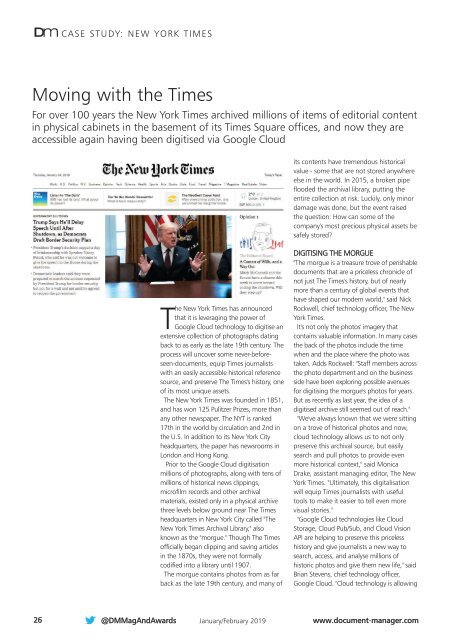DM1901
Create successful ePaper yourself
Turn your PDF publications into a flip-book with our unique Google optimized e-Paper software.
Dm CASE STUDY: NEW YORK TIMES<br />
Moving with the Times<br />
For over 100 years the New York Times archived millions of items of editorial content<br />
in physical cabinets in the basement of its Times Square offices, and now they are<br />
accessible again having been digitised via Google Cloud<br />
its contents have tremendous historical<br />
value - some that are not stored anywhere<br />
else in the world. In 2015, a broken pipe<br />
flooded the archival library, putting the<br />
entire collection at risk. Luckily, only minor<br />
damage was done, but the event raised<br />
the question: How can some of the<br />
company's most precious physical assets be<br />
safely stored?<br />
The New York Times has announced<br />
that it is leveraging the power of<br />
Google Cloud technology to digitise an<br />
extensive collection of photographs dating<br />
back to as early as the late 19th century. The<br />
process will uncover some never-beforeseen-documents,<br />
equip Times journalists<br />
with an easily accessible historical reference<br />
source, and preserve The Times's history, one<br />
of its most unique assets.<br />
The New York Times was founded in 1851,<br />
and has won 125 Pulitzer Prizes, more than<br />
any other newspaper. The NYT is ranked<br />
17th in the world by circulation and 2nd in<br />
the U.S. In addition to its New York City<br />
headquarters, the paper has newsrooms in<br />
London and Hong Kong.<br />
Prior to the Google Cloud digitisation<br />
millions of photographs, along with tens of<br />
millions of historical news clippings,<br />
microfilm records and other archival<br />
materials, existed only in a physical archive<br />
three levels below ground near The Times<br />
headquarters in New York City called "The<br />
New York Times Archival Library," also<br />
known as the "morgue." Though The Times<br />
officially began clipping and saving articles<br />
in the 1870s, they were not formally<br />
codified into a library until 1907.<br />
The morgue contains photos from as far<br />
back as the late 19th century, and many of<br />
DIGITISING THE MORGUE<br />
"The morgue is a treasure trove of perishable<br />
documents that are a priceless chronicle of<br />
not just The Times's history, but of nearly<br />
more than a century of global events that<br />
have shaped our modern world," said Nick<br />
Rockwell, chief technology officer, The New<br />
York Times.<br />
It's not only the photos' imagery that<br />
contains valuable information. In many cases<br />
the back of the photos include the time<br />
when and the place where the photo was<br />
taken. Adds Rockwell: "Staff members across<br />
the photo department and on the business<br />
side have been exploring possible avenues<br />
for digitising the morgue's photos for years.<br />
But as recently as last year, the idea of a<br />
digitised archive still seemed out of reach."<br />
"We've always known that we were sitting<br />
on a trove of historical photos and now,<br />
cloud technology allows us to not only<br />
preserve this archival source, but easily<br />
search and pull photos to provide even<br />
more historical context," said Monica<br />
Drake, assistant managing editor, The New<br />
York Times. "Ultimately, this digitalisation<br />
will equip Times journalists with useful<br />
tools to make it easier to tell even more<br />
visual stories."<br />
"Google Cloud technologies like Cloud<br />
Storage, Cloud Pub/Sub, and Cloud Vision<br />
API are helping to preserve this priceless<br />
history and give journalists a new way to<br />
search, access, and analyse millions of<br />
historic photos and give them new life," said<br />
Brian Stevens, chief technology officer,<br />
Google Cloud. "Cloud technology is allowing<br />
26<br />
@DMMagAndAwards<br />
January/February 2019<br />
www.document-manager.com

















